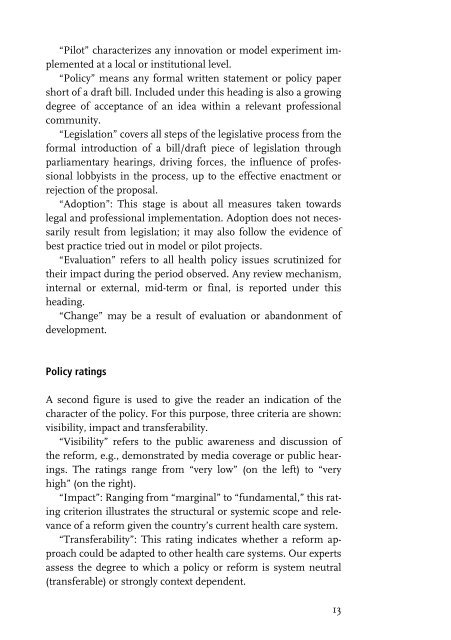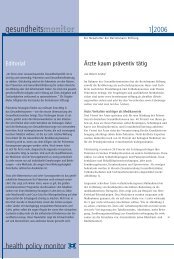The 2nd HPD report - Health Policy Monitor
The 2nd HPD report - Health Policy Monitor
The 2nd HPD report - Health Policy Monitor
- TAGS
- health
- policy
- monitor
- www.hpm.org
You also want an ePaper? Increase the reach of your titles
YUMPU automatically turns print PDFs into web optimized ePapers that Google loves.
“Pilot” characterizes any innovation or model experiment implemented<br />
at a local or institutional level.<br />
“<strong>Policy</strong>” means any formal written statement or policy paper<br />
short of a draft bill. Included under this heading is also a growing<br />
degree of acceptance of an idea within a relevant professional<br />
community.<br />
“Legislation” covers all steps of the legislative process from the<br />
formal introduction of a bill/draft piece of legislation through<br />
parliamentary hearings, driving forces, the influence of professional<br />
lobbyists in the process, up to the effective enactment or<br />
rejection of the proposal.<br />
“Adoption”: This stage is about all measures taken towards<br />
legal and professional implementation. Adoption does not necessarily<br />
result from legislation; it may also follow the evidence of<br />
best practice tried out in model or pilot projects.<br />
“Evaluation” refers to all health policy issues scrutinized for<br />
their impact during the period observed. Any review mechanism,<br />
internal or external, mid-term or final, is <strong>report</strong>ed under this<br />
heading.<br />
“Change” may be a result of evaluation or abandonment of<br />
development.<br />
<strong>Policy</strong> ratings<br />
A second figure is used to give the reader an indication of the<br />
character of the policy. For this purpose, three criteria are shown:<br />
visibility, impact and transferability.<br />
“Visibility” refers to the public awareness and discussion of<br />
the reform, e.g., demonstrated by media coverage or public hearings.<br />
<strong>The</strong> ratings range from “very low” (on the left) to “very<br />
high” (on the right).<br />
“Impact”: Ranging from “marginal” to “fundamental,” this rating<br />
criterion illustrates the structural or systemic scope and relevance<br />
of a reform given the country’s current health care system.<br />
“Transferability”: This rating indicates whether a reform approach<br />
could be adapted to other health care systems. Our experts<br />
assess the degree to which a policy or reform is system neutral<br />
(transferable) or strongly context dependent.<br />
13






